GENERAL INFORMATION AND TRAVEL
Tokyo Metropolitan Government Website
Yokoso Japan
Toei Tokyo Transportation Website
Japan National Tourist Association
Japan Zone
Japan Guide Website
Tokyo Travel and Accommodations
Ginza Concierge
Today's Japan
JAPAN NEWS SITES
Daily Yomiuri Online
The Japan Times
Mainichi Daily Times
Crisscross
Asahi.com
Kyodo News
Japan Herald
The Japan News
NewsOnJapan.com
World News Japan
TheForeigner-Japan.com
Hiragana Times
SeekJapan Japanzine
NHK Online
TEACH ENGLISH IN JAPAN WEBSITES
Aeon Corporation
Nova
Geos
Geos Kids
JET Program
Japan Association for Language Teaching
Dave's ESL Cafe
Ohayo Sensei
English Language Teaching Newsletter
Interac
My name is Jon and I live in Los Angeles. I've visited Japan a lot so that's what this blog is about...visiting Japan, Japanese history and samurai movies.
Daibutsu, Kamakura
Daibutsu in Kamakura, June 2010. There were thousands of school kids visiting that day. It was still great fun.
Friday, September 08, 2006
More Utsunomiya & Crazy Utsunomiya Man

A park in Utsunomiya.
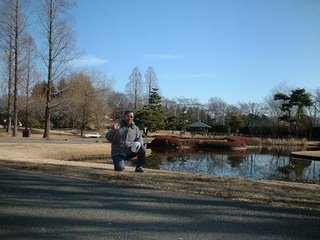
Here is a crazy man at a park in Utsunomiya.
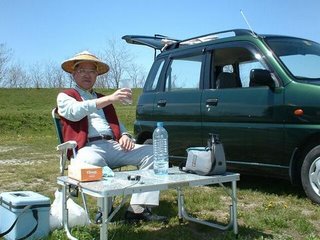
Here's crazy Utsunomiya man enjoying some fine Utsunomiya water.

Here is crazy Utsunomiya man fishing at a local park. I wonder if he caught anything?

Here is crazy man's house. I wonder if he rides that scooter. If he does and you are ever in Utsunomiya, better watch out when you are on the street.

Here is crazy man's house in the summer-time.

Here is his house in winter-time.
Nikko Page
Otawara Page
Japan Home Page
Home
Wednesday, September 06, 2006
More on Utsunomiya
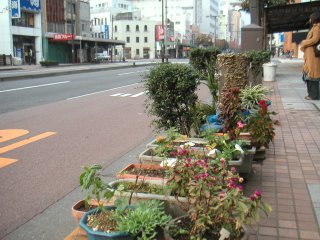
A florist livens up the streetscape in front of their store. I believe the red lane is for buses.
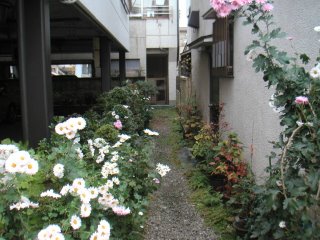
A shorter path between streets, tastefully decorated by a building owner. His bonsai trees are on display nearby.
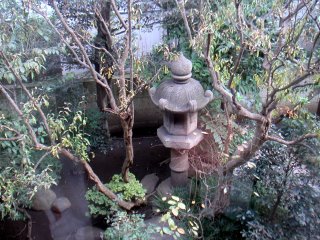
A Japanese garden in Utsunomiya.
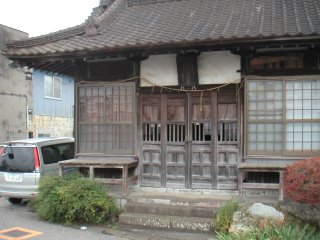
A Historic looking house in Utsunomiya.
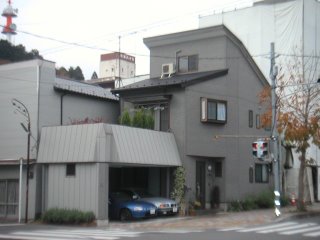
A more modern house. Notice the balcony above the garage. Balcony's are common in Japanese houses. One of the reasons is they provide a place to dry some laundry. Drying laundry outside is fairly common in Japan. However, the balcony must also be a nice place to sit. American architects could learn from this.
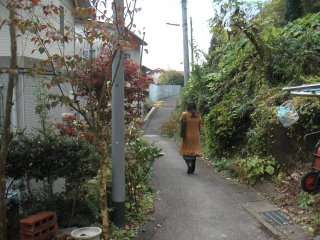
This pedestrian path in Utsunomiya, Japan is the only way to get to a number of houses. You can still find residential areas like this in towns all across Japan.
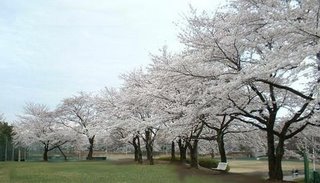
Here is a park in Utsunomiya with cherry blossoms blooming.
Tuesday, September 05, 2006
Utsunomiya, Tochigi, Japan
I visited Utsunomiya while I was in Japan in May, 2006. Utsunomiya is the capital and the most populous city of Tochigi Prefecture, Japan. In 2003 the city had an estimated population of 448,363. The city was founded on 1 April 1896. It is also home of a Canon optical manufacturing plant, a Japan Tobacco plant, Honda automobile plants, and various other industrial concerns in the Kiyohara Industrial Park. In addition, one of the largest malls in the North Kanto region, Bell Mall is located near central Utsunomiya. Utsunomiya is most well known within Japan for gyoza dumplings. Utsunomiya is also well known for its abundance and quality of cocktail bars. (Wikipedia - September, 2006)

This old storage building looks like it is about to come down. Amazing that the owner is parking their car in it. Hope they have insurance.

A shop owner walking his dog? Notice the yellow lines and dots on the sidewalk? These are to assist the blind.
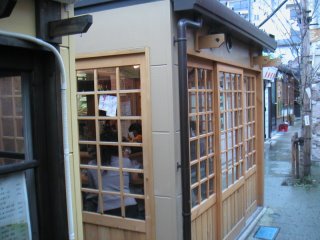
Exterior of an izakaya. That box is the entirety of the restaurant. There are about 10 stools along a U-shaped bar and the kitchen is in the back. That's it. Delicious.

A new developement in Utsunomiya shows hope for small businesses picking up the slack in the economy.Utsunomiya, Japan has suffered in the lengthy recession. At least half of the department stores have gone under. However, this seems to have left the door open for small businesses, which were stomped on by the department stores in the 90s. An interior of the yokochou.

This was built on a former parking lot. Everyone thought the developer was crazy to try and put so many businesses into such a small place. There are 24 restaurants on this narrow lot that spans an entire block.
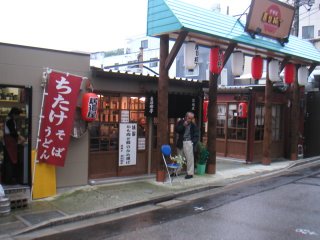
This is the entrance to Utsunomiya's new Yatai-yokochou located in the old city center.
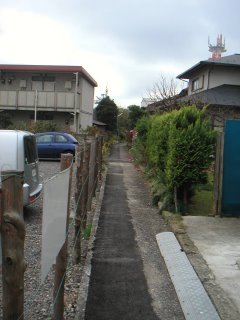
A typical tiny street or path in a Japanese neighborhood. Japanese fire trucks are small, but I'm not sure if they can fit here.

This old storage building looks like it is about to come down. Amazing that the owner is parking their car in it. Hope they have insurance.

A shop owner walking his dog? Notice the yellow lines and dots on the sidewalk? These are to assist the blind.

Exterior of an izakaya. That box is the entirety of the restaurant. There are about 10 stools along a U-shaped bar and the kitchen is in the back. That's it. Delicious.

A new developement in Utsunomiya shows hope for small businesses picking up the slack in the economy.Utsunomiya, Japan has suffered in the lengthy recession. At least half of the department stores have gone under. However, this seems to have left the door open for small businesses, which were stomped on by the department stores in the 90s. An interior of the yokochou.

This was built on a former parking lot. Everyone thought the developer was crazy to try and put so many businesses into such a small place. There are 24 restaurants on this narrow lot that spans an entire block.

This is the entrance to Utsunomiya's new Yatai-yokochou located in the old city center.

A typical tiny street or path in a Japanese neighborhood. Japanese fire trucks are small, but I'm not sure if they can fit here.
Friday, September 01, 2006
Some more pics from Nikko
Here some more pictures from my time spent in Nikko, Tochigi Prefecture.
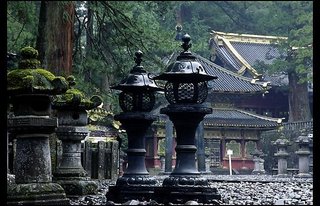
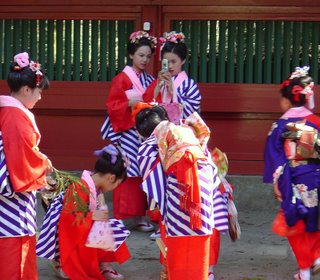
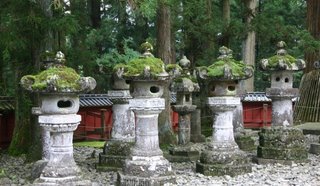


The Yomeimon, probably the most famous work of architecture in Nikko, was erected in 1636 and has been maintained through repeated roofing repair and painting repair to keep it in a condition equal to that at the time of original construction, including its decorative sculpture and other decorative members. It is the most elegantly decorated among the shrine buildings of Toshogu. The great extent of decorative effort peculiar to this particular construction can be seen in the fact that even the structural members are decorated with patterns and sometimes ornamented with sculptures on the surface. Admirable workmanship is recognizable in the decorative expressions produced through a combination of painting, coloring and metal fittings carefully selected in consideration of the subjects or motifs to be expressed in them and the durability of the materials.

The Karadou-torii has been made of bronze, and it is 6m high.The Karadou-torii was the first bronze Torii in Japan. The third successive shogun Iemitsu spent 200,000,000 yen in today's currency. Lotus flower is carved on the foot of the pillars. It is strange that lotus is seen in the shrine because that flower is related to Buddhism.
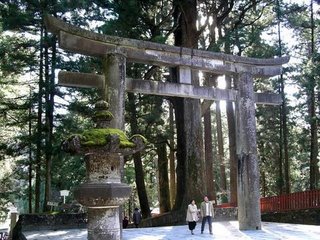
The Ishidorii has remained in its original form since its construction in 1618. The torii gate, which is 9.2 m tall and 13.2 m wide, is made out of 15 blocks of stone, instead of wood, which is the material usually used for torii. The Ishidorii has a unique structure well designed to resist earthquakes; the primary top rail and the secondary top rail, called Kasagi and Shimaki, are hollowed in order to minimize the weight and a pair of grafted stone columns are set firmly to support them.

The Shinkyo, or the sacred bridge, is known to have existed already on the present site spanning the Daiya River in the Muromachi Period (according to remaining archival records) though the exact date of its construction is not clear. It was in 1636 that this bridge took on its present style as a vermilion-lacquered wooden bridge on massive stone piers piled down close to the riverbanks. Though demolished in a flash flood in 1902, it was reconstructed and restored to its 17th -century condition in 1904.

Mt. Nantai, Lake Chuzenji, Nikko National Park. This lake is located about an hour drive in to the mountains from the main town of Nikko. It is up one of the craziest and windiest roads I have ever been on. It is definitely a must see. Below is more information on this area:Generally speaking, central Nikko is recognized as Nikko while area of Lake Chuzenji, around Mt. Nantai and Yumoto are called Oku-Nikko (Inner Nikko), but some people call it just Yumoto area. Border between Nikko and Oku-Nikko is Byoubuiwa rocky screen on the Irohazaka winding road.There are some stories regarding name of Futara. Mt. Nantai is also called Mt. Futara, and the name of Futara is derived from Potalaka in Sanskrit. Also, Futara can be divided into two Japanese words. One is futa, which means two in Japanese, and another word is ara, which means storm. The meaning of combination of those two words are two storms. According to a legend, god of wind and god of thunder appear at Byoubuiwa rocky screen and bring the two storms a year. Moreover, Futara can be pronounced Nikoh in another way of reading. You can imagine that the Nikoh became Nikko later.Landscape of Oku-Nikko has been created dramatically by natural environment like an eruption. Lake, waterfall, grassy plain and marshland are gathered like a miniature garden. Nature has been remained its natural appearance since Oku-Nikko was designated as a National Park in 1934. History of Oku-Nikko began when Priest Shoto succeeded to climb the Mt. Nantai in Nara-Heian period. Nikko developed as a training area for ascetics until Edo period, and developed as a resort area from Meiji era.Weather of Oku-Nikko is relatively cold, but it is comfortable to spend the summer. Plants change their appearances in every season. You should bring chain for your tires when you come to Nikko by the car from December to March. Snow will not be heavy, but surface of the road will possibly be frozen.
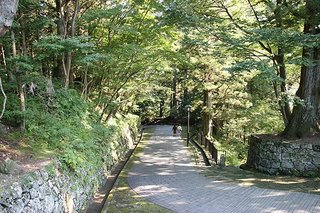


The Gojunoto is an 1818 reconstruction of the original five-storied pagoda, which was erected in 1650, but which was lost in a fire in 1815. In order to make the tower stable enough to resist wind and earthquake forces, the center pillar is suspended on the fourth story and held 10 cm above the ground -- not resting on a foundation stone -- thereby functioning as a dynamic counterweight which maintains the center of gravity.





The Yomeimon, probably the most famous work of architecture in Nikko, was erected in 1636 and has been maintained through repeated roofing repair and painting repair to keep it in a condition equal to that at the time of original construction, including its decorative sculpture and other decorative members. It is the most elegantly decorated among the shrine buildings of Toshogu. The great extent of decorative effort peculiar to this particular construction can be seen in the fact that even the structural members are decorated with patterns and sometimes ornamented with sculptures on the surface. Admirable workmanship is recognizable in the decorative expressions produced through a combination of painting, coloring and metal fittings carefully selected in consideration of the subjects or motifs to be expressed in them and the durability of the materials.

The Karadou-torii has been made of bronze, and it is 6m high.The Karadou-torii was the first bronze Torii in Japan. The third successive shogun Iemitsu spent 200,000,000 yen in today's currency. Lotus flower is carved on the foot of the pillars. It is strange that lotus is seen in the shrine because that flower is related to Buddhism.

The Ishidorii has remained in its original form since its construction in 1618. The torii gate, which is 9.2 m tall and 13.2 m wide, is made out of 15 blocks of stone, instead of wood, which is the material usually used for torii. The Ishidorii has a unique structure well designed to resist earthquakes; the primary top rail and the secondary top rail, called Kasagi and Shimaki, are hollowed in order to minimize the weight and a pair of grafted stone columns are set firmly to support them.

The Shinkyo, or the sacred bridge, is known to have existed already on the present site spanning the Daiya River in the Muromachi Period (according to remaining archival records) though the exact date of its construction is not clear. It was in 1636 that this bridge took on its present style as a vermilion-lacquered wooden bridge on massive stone piers piled down close to the riverbanks. Though demolished in a flash flood in 1902, it was reconstructed and restored to its 17th -century condition in 1904.

Mt. Nantai, Lake Chuzenji, Nikko National Park. This lake is located about an hour drive in to the mountains from the main town of Nikko. It is up one of the craziest and windiest roads I have ever been on. It is definitely a must see. Below is more information on this area:Generally speaking, central Nikko is recognized as Nikko while area of Lake Chuzenji, around Mt. Nantai and Yumoto are called Oku-Nikko (Inner Nikko), but some people call it just Yumoto area. Border between Nikko and Oku-Nikko is Byoubuiwa rocky screen on the Irohazaka winding road.There are some stories regarding name of Futara. Mt. Nantai is also called Mt. Futara, and the name of Futara is derived from Potalaka in Sanskrit. Also, Futara can be divided into two Japanese words. One is futa, which means two in Japanese, and another word is ara, which means storm. The meaning of combination of those two words are two storms. According to a legend, god of wind and god of thunder appear at Byoubuiwa rocky screen and bring the two storms a year. Moreover, Futara can be pronounced Nikoh in another way of reading. You can imagine that the Nikoh became Nikko later.Landscape of Oku-Nikko has been created dramatically by natural environment like an eruption. Lake, waterfall, grassy plain and marshland are gathered like a miniature garden. Nature has been remained its natural appearance since Oku-Nikko was designated as a National Park in 1934. History of Oku-Nikko began when Priest Shoto succeeded to climb the Mt. Nantai in Nara-Heian period. Nikko developed as a training area for ascetics until Edo period, and developed as a resort area from Meiji era.Weather of Oku-Nikko is relatively cold, but it is comfortable to spend the summer. Plants change their appearances in every season. You should bring chain for your tires when you come to Nikko by the car from December to March. Snow will not be heavy, but surface of the road will possibly be frozen.



The Gojunoto is an 1818 reconstruction of the original five-storied pagoda, which was erected in 1650, but which was lost in a fire in 1815. In order to make the tower stable enough to resist wind and earthquake forces, the center pillar is suspended on the fourth story and held 10 cm above the ground -- not resting on a foundation stone -- thereby functioning as a dynamic counterweight which maintains the center of gravity.
Subscribe to:
Posts (Atom)